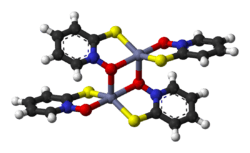Zinc pyrithione
 | |
 | |
| Names | |
|---|---|
| IUPAC name
bis(2-pyridylthio)zinc 1,1'-dioxide | |
| Other names
ZnP, pyrithione zinc, zinc OMADINE | |
| Identifiers | |
| 13463-41-7 | |
| 3D model (Jmol) | Interactive image |
| ChEMBL | ChEMBL1200471 |
| ChemSpider | 21513957 |
| ECHA InfoCard | 100.033.324 |
| PubChem | 3005837 |
| UNII | R953O2RHZ5 |
| |
| |
| Properties | |
| C10H8N2O2S2Zn | |
| Molar mass | 317.70 g/mol |
| Appearance | colourless solid |
| Melting point | 240 °C (464 °F; 513 K) (decomposition) [1] |
| Boiling point | decomposes |
| 8 ppm (pH 7) | |
| Pharmacology | |
| D11AX12 (WHO) | |
| Except where otherwise noted, data are given for materials in their standard state (at 25 °C [77 °F], 100 kPa). | |
| | |
| Infobox references | |
Zinc pyrithione (or pyrithione zinc) is a coordination complex of zinc. It has fungistatic (that is, it inhibits the division of fungal cells) and bacteriostatic (inhibits bacterial cell division) properties and is used in the treatment of seborrhoeic dermatitis.[2]
Structure of the compound
The pyrithione ligands, which are formally monoanions, are chelated to Zn2+ via oxygen and sulfur centers. In the crystalline state, zinc pyrithione exists as a centrosymmetric dimer (see figure), where each zinc is bonded to two sulfur and three oxygen centers.[3] In solution, however, the dimers dissociate via scission of one Zn-O bond.
This compound was first described in the 1930s.[4]
Pyrithione is the conjugate base derived from 2-mercaptopyridine-N-oxide (CAS# 1121-31-9), a derivative of pyridine-N-oxide.
Uses
Medical
Zinc pyrithione is best known for its use in treating dandruff and seborrhoeic dermatitis,[5] particularly in dandruff shampoos. It also has antibacterial properties and is effective against many pathogens from the Streptococcus and Staphylococcus genera. Its other medical applications include treatments of psoriasis, eczema, ringworm, fungus, athletes foot, dry skin, atopic dermatitis, tinea, and vitiligo.
In paint
Due to its low solubility in water (8 ppm at neutral pH), zinc pyrithione is suitable for use in outdoor paints and other products that provide protection against mildew and algae. It is an effective algaecide. It is chemically incompatible with paints relying on metal carboxylate curing agents. When used in latex paints with water containing high amount of iron, a sequestering agent that will preferentially bind the iron ions is needed. Its decomposition by ultraviolet light is slow, providing years of protection even against direct sunlight.
In sponges
Zinc pyrithione is also used as an antibacterial treatment for household sponges, most notably by the 3M Corporation.[6]
Mechanism of action
Its antifungal effect is thought to derive from its ability to disrupt membrane transport by blocking the proton pump that energizes the transport mechanism.[7]
Health effects
Zinc pyrithione is approved for over-the-counter topical use in the United States as a treatment for dandruff and is the active ingredient in several antidandruff shampoos. However, in its industrial forms and strengths, it may be harmful by contact or ingestion. Zinc pyrithione can trigger a variety of responses.[8]
Brands
Head & Shoulders is an American brand of anti-dandruff and non-dandruff shampoo produced by parent company Procter & Gamble that was introduced in 1961.[9] The active ingredient is pyrithione zinc.[10]
See also
- Selenium disulfide, an active ingredient used in shampoos such as Selsun Blue.
- Ketoconazole, another antifungal agent used in shampoos.
References
- ↑ Thieme Chemistry (Hrsg.): Römpp Online. Version 3.1. Georg Thieme Verlag, Stuttgart 2007.
- ↑ Brayfield, A, ed. (23 September 2011). "Pyrithione Zinc". Martindale: The Complete Drug Reference. Pharmaceutical Press. Retrieved 28 March 2014.
- ↑ Barnett, B. L.; Kretschmar, H. C.; Hartman, F. A. (1977). "Structural characterization of bis(N-oxopyridine-2-thionato)zinc(II)". Inorg. Chem. 16 (8): 1834–8. doi:10.1021/ic50174a002.
- ↑ "astate.edu". Archived from the original on 2007-06-21. Retrieved 2007-08-24.
- ↑ Faergemann, J. American Journal of Clinical Dermatology (2000). "Management of Seborrheic Dermatitis and Pityriasis Versicolor". 1: 75–80. ISSN 1175-0561.
- ↑ Notice of Filing a Pesticide Petition to Establish
- ↑ Chandler CJ, Segel IH (1978). "Mechanism of the Antimicrobial Action of Pyrithione: Effects on Membrane Transport, ATP Levels, and Protein Synthesis". Antimicrob. Agents Chemother. 14 (1): 60–8. doi:10.1128/aac.14.1.60. PMC 352405
 . PMID 28693.
. PMID 28693.
- ↑ Leading references: Lamore SD, Cabello CM, Wondrak GT (May 2010). "The topical antimicrobial zinc pyrithione is a heat shock response inducer that causes DNA damage and PARP-dependent energy crisis in cultured human skin cells.". Cell Stress Chaperones. 15 (3): 309–22. doi:10.1007/s12192-009-0145-6. PMC 2866994
 . PMID 19809895.
. PMID 19809895. - ↑ Davis, Dyer; et al. (May 1, 2004). Rising Tide: Lessons from 165 Years of Brand Building at Procter and Gamble. Harvard Business Press. p. 423. Retrieved 2013-05-07.
- ↑ Label: Head and Shoulders (pyrithione zinc)
External links
- Some toxicity information on industrial uses
- Article Omni Brain: Dandruff Shampoo to Calm Seizures, Apr. 2007
- Record in the Household Products Database of NLM